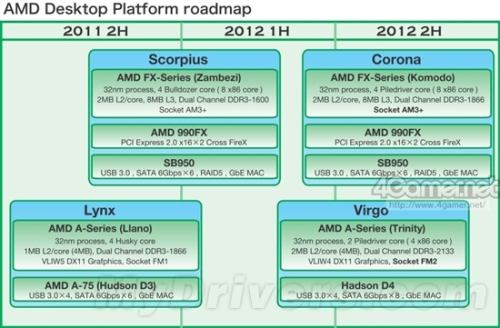 Special reminder: This article comes from the Japanese website 4gamer. Net, does not represent AMD official plan, may also change, for reference only.
Special reminder: This article comes from the Japanese website 4gamer. Net, does not represent AMD official plan, may also change, for reference only. Previously, it was reported that AMD's 2012 second-generation bulldozer processor "Komodo" and APU processor "Trinity" will share the new socket interface Socket FMx, but the latest unofficial roadmap shows that next year's bulldozer will continue With Socket AM3+, the interface of Trinity APU is named Socket FM2.
According to this roadmap, the Komodo processor is scheduled to be released in the second quarter of 2012 and will still be named the FX series. The package interface is Socket AM3+ just like the current Zambezi FX series, and the same chipset will continue to be 990FX and SB950. Change, this guarantees full backward compatibility. In other words, users who are currently purchasing 9 series motherboards will be able to upgrade to enhanced bulldozers by refreshing the BIOS next year.
If it is good news that the interface is not compatible, the number of cores and memory frequency will be worse. Komodo was originally planned to be equipped with up to 10 cores, but now it has been reduced to 8 and it is exactly the same now. In terms of memory frequency, Zambeizi originally planned to support DDR3-1866, but it is now downgraded to DDR3-1600. Only by Komodo will it achieve DDR3-1866.
The Komodo processor plus 9 series chipsets will form the next generation of high-end desktop platform "Corona" (Northern Capricorn/Nanometer), replacing the existing "Scorpius" (Scorpio).
This also means that AMD's processors and motherboards will not support PCI-E 3.0 in 2012. It is said that because AMD and NVIDIA are all dissatisfied with the PCI-E 3.0 specification, they may even cancel their support and instead wait for the more distant PCI-E 4.0. Will the South Islands and Kepler support PCI-E 3.0?
The Trinity APU will also be released in the second quarter of 2012 but earlier in Komodo, it will continue to be named as the A series. The encapsulation interface will be changed from Socket FM1 to Socket FM2, and the pin count will be reduced from 905 to 904. It will remain backward compatible. In other words, the current A75/A55 FM1 motherboard can also be upgraded to second-generation A-series APUs next year.
The new "Hudson D4" is added to the chipset. The main change is that the SATA 6Gbps interface has increased from six to eight, and the USB 3.0 interface has remained at four. The new platform codename "Virgo" (Virgo) is expected to issue design specifications to OEM PC makers and motherboard makers in September this year.
The Komodo processor has up to four "Piledriver" modules, eight core x86 cores, or 32nm manufacturing process, 2MB of L2 cache per core, up to 8MB of L3 cache, and the architecture will be enhanced on the basis of existing bulldozers, including Improved AVX instruction set compatibility, FMA multi-instruction support three operations (FMA3), support for BMI bit manipulation instructions, and other new instructions, while supporting third-generation dynamic acceleration technology Turbo Core 3.0, the overall performance can therefore be improved by approximately 10%.
The Trinity APU has up to two Piledriver modules and four x86 cores. The graphics core uses the VLIW4 stream processor architecture and adds the Secure Asset Management Unit (SAMU), Video Compression Engine (VCE), and also supports Eyefinity technology up to four screens. Output.
For the high bandwidth requirements of the APU, Trinity's memory frequency will once again be raised to DDR3-2133, continuing to be one grade higher than that of a simple bulldozer.
In addition, AMD plans to ship 1.5-2.0 million Llano A-series APUs in the second quarter of this year, increasing to 4.5-5 million in the fourth quarter.
Finally, take a look at the next generation ultra-low-power APU Wichta, up to four Bobcat architecture x86 core and support Turbo Core 3.0 dynamic acceleration technology, memory support to DDR3-1600, while directly integrating the FCH chipset "Yuba" native support SATA 6Gbps, USB 3.0, only one single chip remains on the entire platform.
Wichta will use a new 28nm process, thermal design power up to 20W.
Stainless Steel Table Lamp,Laser-Cutted Lamps,Mirror Pendant Lamp
Table Lamp Wall Lamp Co.,Ltd , http://www.nspendantlamp.com